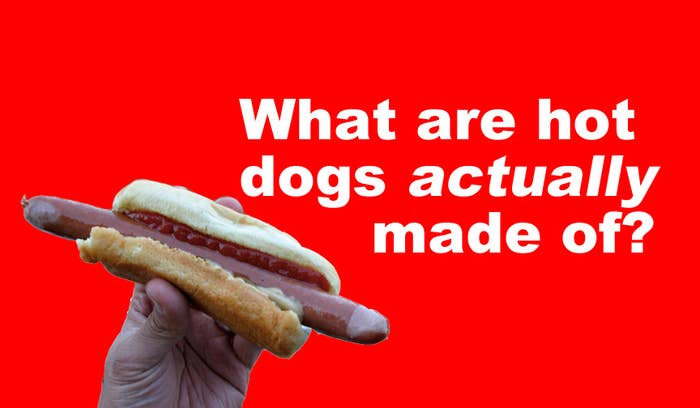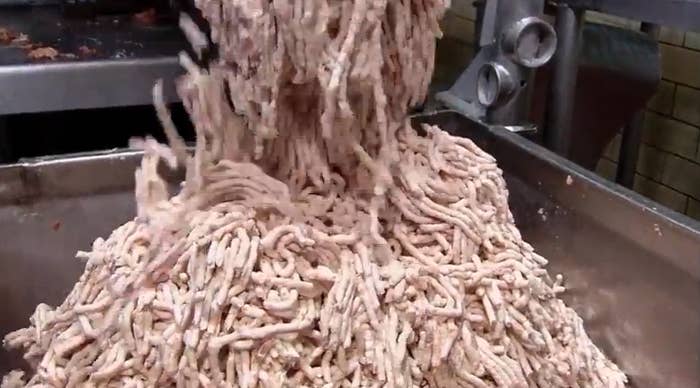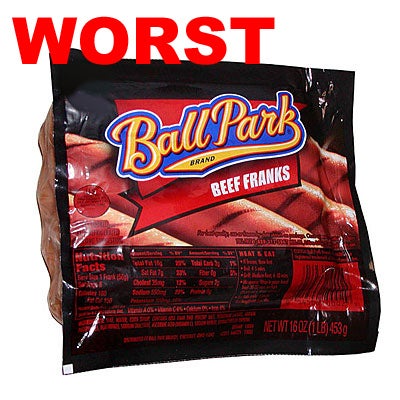With help from a dietician at the American Cancer Society and Bizarre Foods' Andrew Zimmern, who now owns his own line of franks, we aimed to demystify the delicious sausage. Here are some of the most curious questions about hot dogs with facts you can't unknow.

Most commercial hot dogs are a mash of poultry trimmings, water, corn syrup, and starchy "filler."

If you're buying classic hot dogs made by Oscar Mayer or Ball Park, the primary ingredient is likely going to be chicken or turkey — specifically "mechanically-separated" turkey or chicken. The USDA defines that as a "paste-like and batter-like poultry product," which is made by forcing trimmings through a machine that separates any "attached edible tissue" from the bone. However, if the hot dog package says "beef franks" or "pork franks" it is required by law to contain only meat from that single species of animal.
"The joke in the modern era is that hot dogs are just lips and asshole," Bizarre Foods host Andrew Zimmern told BuzzFeed. Commercial hot dogs are in fact made of trimmings: leftover poultry and meat parts after the rest of the animal has been turned into more premium cuts. But even though most people might find that idea unappetizing, Zimmern says some of those parts actually have "some of the best flavor and fat content," and that's not what's giving hot dogs a bad name. Rather, it's all the fillers that go in after the meat or poultry. "[Hot dogs] should be 100% natural, no artificial anything, species-specific," says Zimmern. "Those are the things that people can taste."

After every edible thing is forced off the bone of those poultry parts, the tissue is ground up and mixed with the other ingredients...
The other ingredients in order of amount typically are: water, corn syrup, salt, preservatives, a starchy cereal filler, and artificial flavors.
...until it becomes a load of gloopy puree.
Then the gloop gets stuffed into synthetic collagen casings...
...and run through a smoke-shower vault.

Even eating small amounts may cause cancer.
So, what's a "healthy" intake of hot dogs?
Then again, not all hot dogs are made equal. Some are slightly healthier than others.


Look for hot dogs with without antibiotics and hormones and a lower calorie, fat, and sodium content than others. (Commercial hot dogs, like mainstream Oscar Mayer wieners come in at about 150 calories, 15g of fat, and 450mg of sodium.) Mens Health has a great guide to the best and worst hot dogs you can buy, health wise.
But also be wary about flashy labels and always check the ingredients for yourself. "Even if something says it's 'uncured' or 'no nitrites/nitrates,' they can still have those compounds added to them," warns Doyle. "It's hard to avoid preservatives. That's why hot dogs have such long shelf life. I always encourage people to read the labels. If it's a processed meat, you can be sure there's some kind of compound in there."
Zimmern agrees: "If you look at the back of a package, if there are any preservatives — if the meat can't be traced to a farmer with a name — I don't think commercial hot dogs are one of the things to be super proud of."

Short answer: Kinda.


Mostly nope.

Apparently at a hot dog stand in the Frankfurt, Germany airport.


